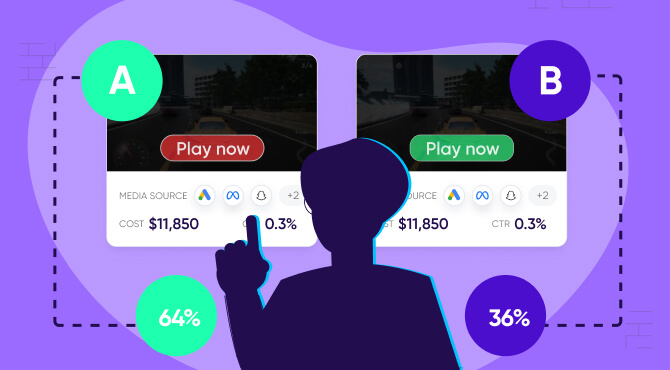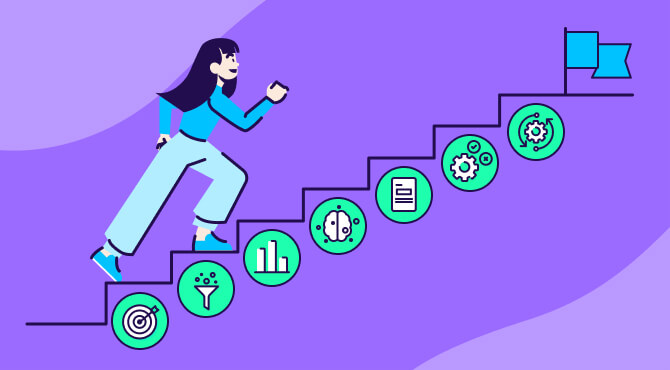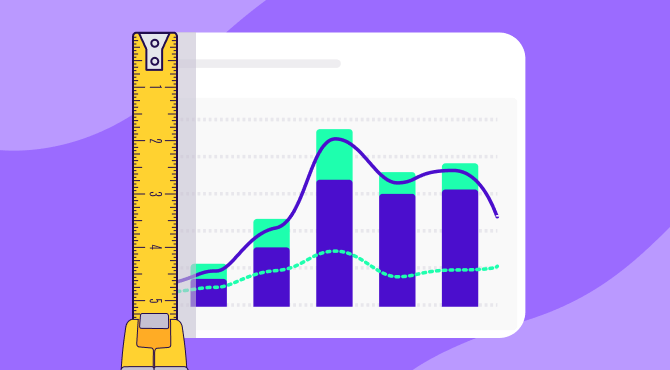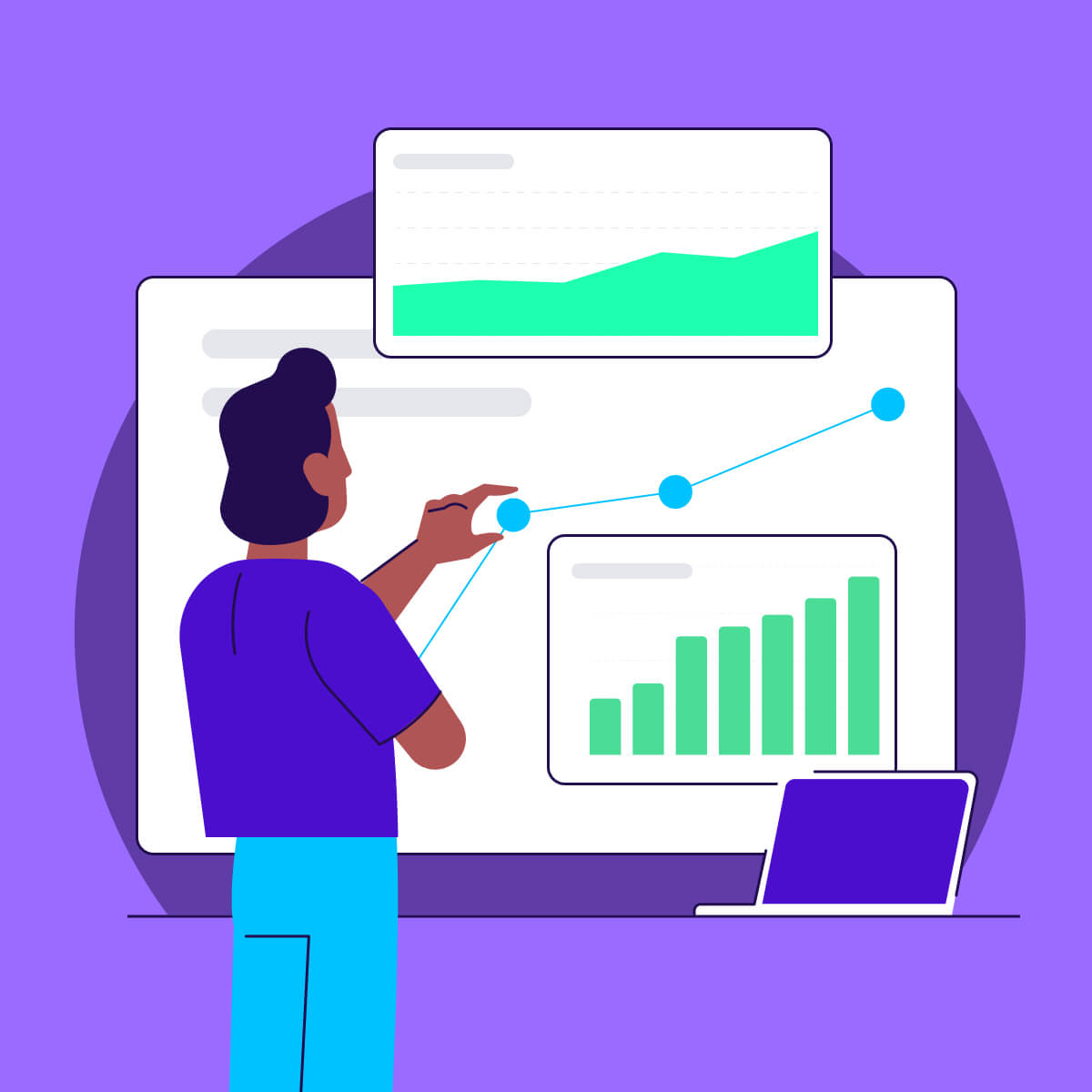
Mastering creative analytics: where data meets design
Creativity and data, like yin and yang, have long been perceived as polar opposites.
However, in today’s privacy-first world where technology reigns supreme, the traditional ways of optimizing ad creative campaigns are rapidly fading into obsolescence.
Marketers are adapting to a new reality where numbers and insights have taken center stage. Data analytics has become their compass, guiding them to create marketing strategies that resonate more effectively.
This fascinating evolution of marketing has given rise to a fresh concept, bridging the gap between the art of creative content and the science of data analytics: creative analytics.
What is creative analytics?

Creative analytics is the systematic process of collecting and analyzing data related to your marketing material or ad creatives. This provides you with valuable insights that you can use to make better creatives, refining your brand’s storytelling.
In contrast to traditional data analytics, which primarily focuses on numerical data, creative analytics highlights the qualitative aspects of marketing. It helps you understand how the creative elements of your campaigns impact consumer behavior and engagement.
So, here’s the deal: when you dive into creative analytics, you’re setting yourself up for better engagement in your marketing campaigns. And when that happens, you’re looking at a boost in your return on ad spend (ROAS) and return on investment (ROI).
Real-life creative analytics example: Mallzee
Mallzee, a UK-based non-retail fashion shopping app, was already a big player in the industry, but they had a problem: a low conversion rate. While the app attracted ample traffic, they needed more people to download it.
To tackle this issue head on, Mallzee turned to creative analytics. They initiated a series of A/B tests, experimenting with the app’s icon, title, subtitle, description, and screenshots. This strategic approach, complemented by standard app store optimization, ensured they didn’t accidentally make their conversion rate worse.
The outcome was nothing short of remarkable: Mallzee’s conversion rate jumped 10%!
Clearly, by steering you towards the right tweaks, creative analytics can make a big difference.
Benefits of creative analytics
Let’s quickly review the main benefits of creative analytics:
Unveils audience insights
The creative analysis goes beyond mere numbers; it delves into your audience’s innermost preferences and interests, offering a fresh perspective that helps you grasp their genuine desires. This knowledge becomes the foundation for building compelling marketing campaigns that not only capture user attention but also enhance engagement.

Promotes creative imagination
With creative analytics, you don’t get bogged down in data — instead, it encourages you to explore innovative ideas. It serves as an avenue for unbridled creativity, fostering brilliant concepts that go beyond the ordinary.
Increases ROI and ROAS
Boosting ROI and ROAS is a shared ambition for all app marketers. Creative analysis brings you closer to your goals, by providing valuable insights into how audiences respond to diverse creative content. With this understanding, you can allocate your budget more effectively and achieve better results.
Improves marketing effectiveness
Creative analytics serves as the cornerstone for refining your marketing campaigns. It helps you craft personalized messaging and experiences that align with strategic goals, whether it’s increasing brand awareness, driving website traffic, or fostering genuine audience engagement.
Provides a competitive edge
By combining data-driven insights with creative strategies, you can craft campaigns that make your app stand out in today’s competitive marketplace. Creative analysis also provides a window into your competitors’ strategies, so you can shape precise marketing plans that give you the edge. This ultimately cultivates brand loyalty and maintains customer engagement, solidifying your position as an industry leader.
How to use creative analytics
How you use creative analytics will vary depending on your app. However, there are certain foundational steps you can follow to get things rolling.

Step 1: Set your creative goals
What do you want to achieve from your marketing campaigns?
Before analyzing your creative data, create SMART goals — specific, measurable, attainable, relevant, and time-bound — for your marketing initiatives. Think: improved conversion rates, better optics, increasing app downloads.
This will give you a framework to evaluate your marketing efforts and determine whether you’re making progress toward your desired outcomes later. You can also make educated guesses about which creative elements will yield the best results.
Step 2: Collect creative data
Next, start collecting relevant data on your marketing efforts. This includes periodical data related to your website traffic, email marketing, and social media campaigns.
It’s also worth running a competitor creative analysis to identify the creatives direct competitors are using on different user acquisition channels. What’s working well for them, and where could you do better?
Make use of available measurement and analytics tools while you’re at it. Tools like AppsFlyer, Google Analytics, and other social media and email analytics platforms help simplify data collection.
Step 3: Analyze your data
What is your data telling you?
To find the answers, examine your creatives and historical ad performance to determine the effectiveness of your marketing strategies and identify areas for improvement. Pay close attention to crucial metrics, such as ad impressions, conversion rates, click-through rates, and ROI.
Step 4: Brainstorm and incorporate feedback
Using the wealth of insights from your research, it’s time to get creative by brainstorming potential marketing strategies.
You can also bring in product managers and app designers, encouraging them to share their unique perspectives. Be open to incorporating their feedback, whether it entails adjusting your messaging or reallocating your marketing budget. Creative analytics is very much a team effort.
Step 5: Prepare a creative brief
Document all the creative concepts you and your team generated in Step 4 in the form of a creative brief. Consider structuring it like a storyboard so that everyone’s clear about the core concept, individual elements, and messaging of the brief.
Step 6: Test, test, test
Analyze the performance metrics of each of your user acquisition channels ( Facebook or TikTok, for example), making sure you understand why certain creatives outperform others. Then apply the insights gained from testing to your ongoing marketing campaigns.
At this stage, you should also consider different testing frameworks like impression to install rate (IPM), multistep, value optimization (VO), and business as usual (BAU) to determine which best suits your specific needs.
This way, you’ll be better equipped to optimize your campaigns across various channels.
Step 7: Optimize and repeat
As a marketer, you need to be cautious about relying solely on last-touch attribution. For instance, when you run an ad on Facebook using this attribution model and no MMP (mobile measurement partner), Facebook claims 100% of the credit for conversions. That’s misleading.
To get a more accurate picture, you should use a mixed measurement approach that includes incrementality tests. Incrementality testing focuses on the extra conversions that wouldn’t have occurred naturally, showing the real impact of the ad. In other words, it reveals the conversions directly caused by the ad itself.
Moreover, two advanced techniques, namely media mix modeling (MMM) and predictive modeling, offer a more holistic view of your marketing efforts.
- Media mix modeling, also referred to as marketing mix modeling, evaluates how various factors, from consumer trends to external influencers, come together to create a well-rounded campaign that boosts engagement and ROI.
- Predictive modeling forecasts audience behavior over a defined period based on historical data.
Using both approaches strategically, you can make educated creative decisions to optimize your marketing campaigns across multiple channels — all without compromising user privacy.
Which KPIs should you measure?

With so much marketing data available, how do you decide which stats are most relevant to your creative efforts? Here’s a list of quantifiable measures, or KPIs, you can use to gauge and improve your marketing campaign‘s performance over time:
1 — Impressions
Impressions tell you how many times your ad pops up on someone’s screen. They’re the first checkpoint of your creative content, indicating whether your creative assets are reaching the right eyeballs.
2 — Conversion rate (CVR)
CVR measures the percentage of viewers who take your desired action (such as filling out a form) after seeing the ad. Marketing campaigns with a high CVR are successful in driving desirable behavior among your target audience.
Don’t confuse CVR with CTR (click-through rate), which indicates the number of users who click on a link after engaging with your marketing content. A high CTR means your ad is effective and inspiring action, and vice versa. Think of it as a report card of your ad CTAs.
3 — Average watch time
Average watch time calculates the total duration viewers stay tuned to your video content. You can use it to understand how effective your ad is at attracting and holding the viewer’s attention. Naturally, a longer average watch time signals you’re producing more engaging content.
4 — 3-second video viewers ratio
This KPI goes beyond impressions, delving into user engagement.
The 3-second video viewers ratio tells you the percentage of viewers who watch your video for at least three seconds, compared to total impressions. A higher ratio indicates your content is resonating with your targeted audience.
5 — Cost per acquisition (CPA)
CPA keeps tabs on how much you’re spending to acquire every new lead or user. This is a crucial KPI to manage your marketing budget and acquisition efforts.
6 — Cost per conversion (CPC)
CPC is similar to CPA, but rather than costing up acquisitions, it shows what you pay for every successful conversion. You can use it to better understand the effectiveness of your advertising efforts and make smarter budgeting decisions.
7 — Ad spend
Ad spend is the grand total of your investments in advertising campaigns. Managing your marketing budget is crucial, and this metric helps you keep track of your overall spending.
8 — ROAS
ROAS is the sum of revenue generated from your ad spending. It provides a clear, straightforward perspective on the overall return from your advertising campaigns.
9 — ROI
ROI refers to the total revenue amount generated as a direct result of your marketing efforts compared to the total investment in implementing those efforts. It assesses the effectiveness of your marketing campaigns and whether they’re generating a positive return on investment for your business.
Compared to ROAS, ROI is a bigger-picture metric: while ROAS looks at revenue, ROI focuses on profit.
The impact of AI on creative analytics
AI has forever changed marketing, and creative analytics is no different.
Marketers are now increasingly using this innovative tech to optimize the creative elements within their campaigns, and not immediately jumping on this bandwagon means you’re leaving money on the table… for your competitors.
Here’s a closer look at the impact of AI on creative analytics:

Evaluating creative elements
AI-powered creative analysis can help you understand what resonates with your audience, facilitating educated creative decisions.
For instance, in the case of a video asset, AI can identify which specific creative components yield the most favorable outcomes. This can be anything, from the number of actors to the tone of voice to the video duration.
Previously, marketers relied on their intuition and experience to conceive creative campaign ideas. Now, they have AI and machine learning to provide a fresh perspective on what works and what doesn’t.
Going beyond A/B testing
Sure, traditional A/B testing has its merits, but introducing AI to the mix takes things several steps further.
AI-driven creative analytics is adept at processing vast amounts of data and highlighting subtle differences that might escape human observation. Continuing with our previous example, AI can tell you the impact of factors such as the number of people featured in the video or the emotional tone conveyed within an ad on audience engagement and conversions.
These granular insights can be invaluable for refining creative content to ensure maximum impact.
The privacy-driven landscape
Policy changes from tech giants like Apple and Google, which impose restrictions on data collection and tracking, mean you now have less audience data available for traditional targeting efforts.
Luckily, AI-driven creative analytics is a viable solution to this problem. Instead of shining the spotlight on your audience themselves, it focuses on the creative elements that resonate most effectively with them. So, you no longer need to lean solely on audience data to create and refine your marketing campaigns.
AI as a potential barrier
Despite the immense potential for creative analysis, AI can be a double-edged sword.
For many marketers, working with AI is a challenging or intimidating prospect. That’s why it’s important to bridge the knowledge gap and ensure your team has a solid understanding of how AI and creative analytics work.
If you put in that effort now, you’ll soon reap the benefits. As well as sharpening creativity, AI-powered solutions can simplify asset organization, ensure regulatory compliance, and establish effective team workflows. This ultimately enables marketing teams to execute successful marketing campaigns within budget constraints.
Key takeaways
- Creative analytics involves collecting and analyzing data on your marketing materials or ad creatives to help you refine creative campaigns. It focuses on the qualitative aspects of marketing, helping you understand how your creative elements affect consumer behavior and engagement.
- For app marketers, creative analytics can reveal audience insights, stimulate creative ideas, and boost campaign ROI and ROAS. It also enhances marketing effectiveness, giving apps a competitive edge.
- To use creative analytics effectively for your app, follow these steps: Set SMART creative goals, collect relevant data, analyze performance metrics, document your ideas in a creative brief, and test and optimize your campaigns across various channels.
- Marketers should use mixed measurement methods like incrementality testing, media mix modeling, and predictive modeling to make informed creative decisions while respecting user privacy.
- AI-driven creative analytics helps you make smarter decisions by identifying effective creative components. Use it to enhance A/B testing and optimize campaigns without relying on privacy-protected audience data.
- Building a deep understanding of AI and creative analytics within your team will help you reap the benefits, which include enhanced creativity, regulatory compliance, and streamlined workflows, enabling successful campaigns within budget limits.





